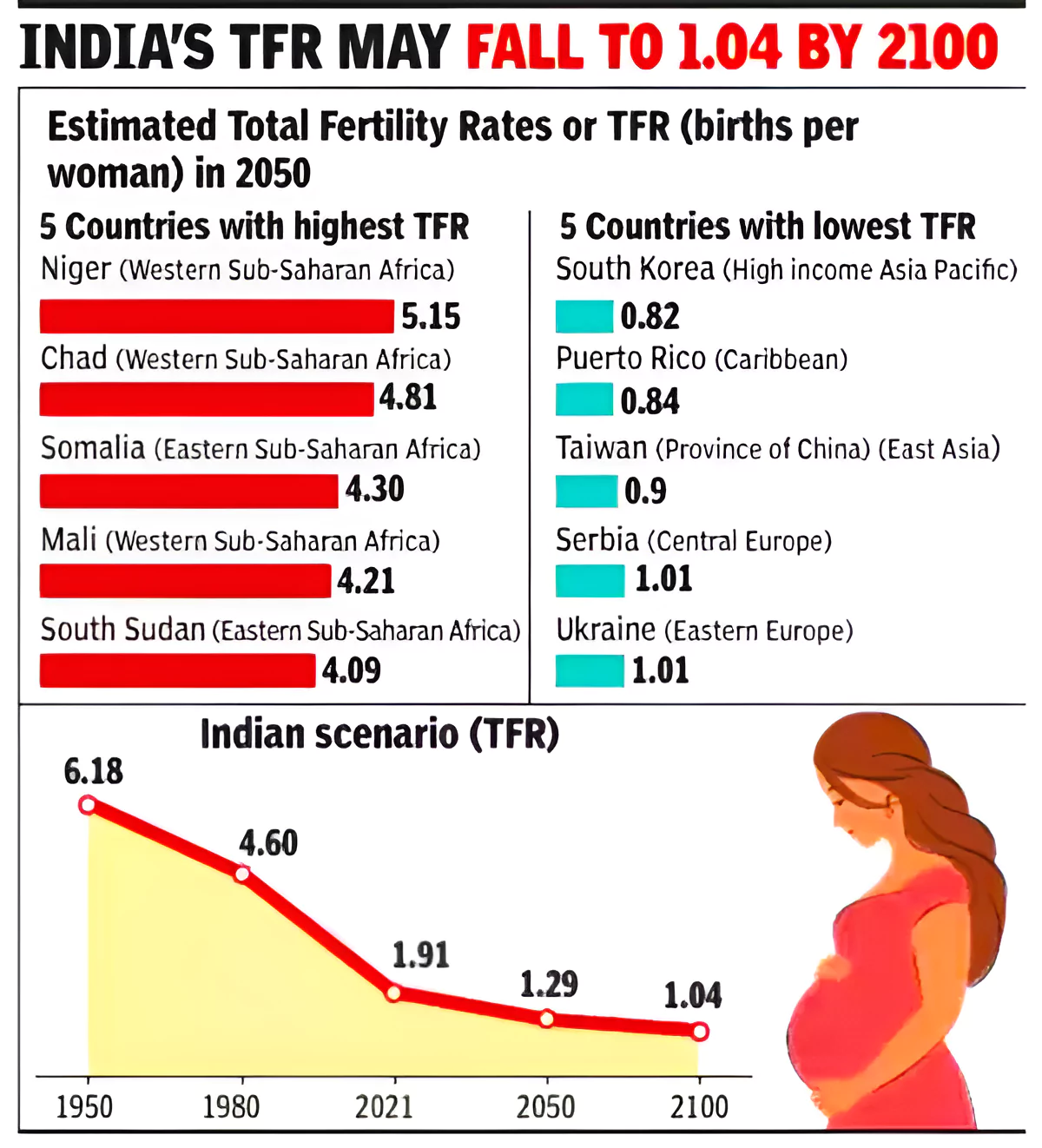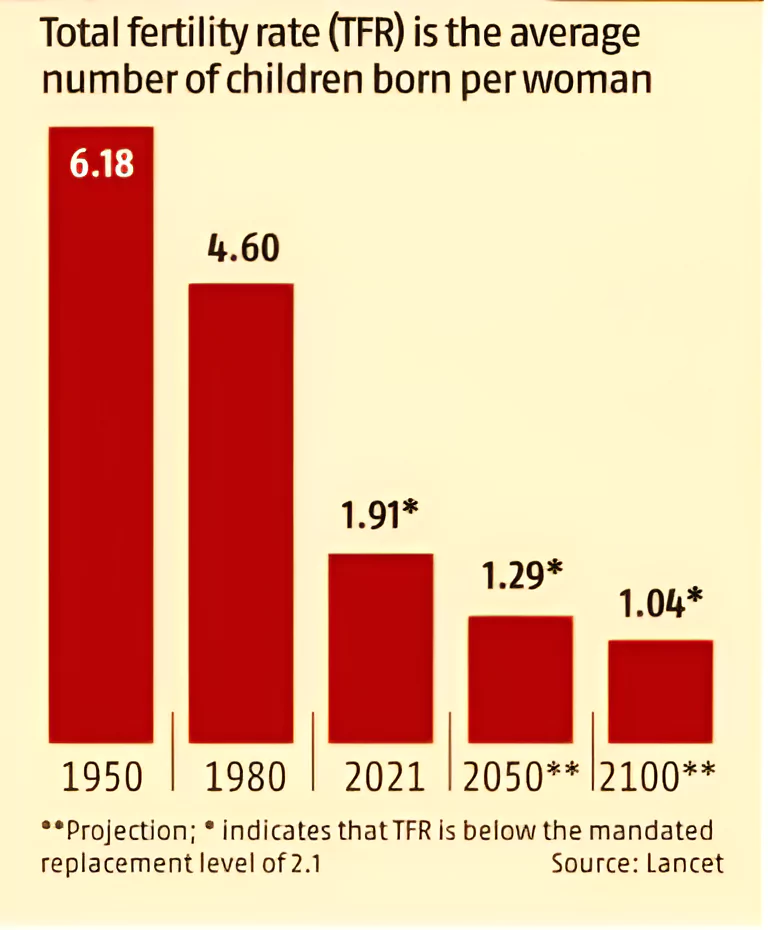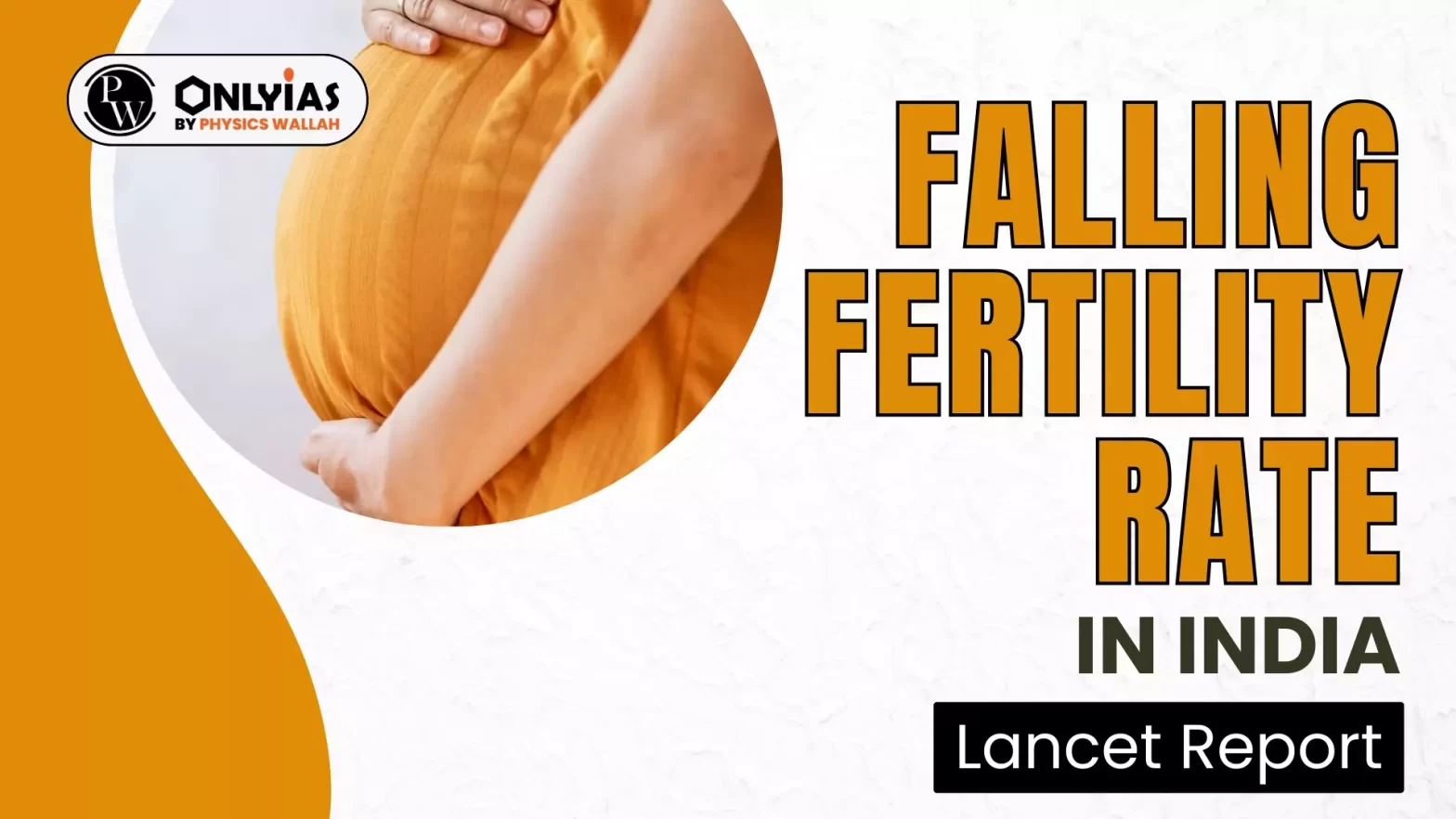Context
The Lancet Report flagged that India’s Total Fertility Rate (TFR) will fall to 1.29 in 2050, significantly below the replacement threshold of 2.1.
- The Lancet estimate is based on a complex demographic modelling, done for 204 countries as part of the global burden of disease study.
Key Findings of the Lancet Report On Fertility Rate in India & Global
-
Fertility Rate in India:
- TFR Evolution: The total fertility rate in India stood at 6.18 in 1950, dropped to 4.60 in 1980, and subsequently decreased to 1.91 by 2021.
- Future Projection:
- By 2050, one in five people in India will be above the age of 60 in 2050, signaling a transition towards an aging population akin to the demographic challenges currently faced by China.
- Earlier, the UN Population Fund’s (UNPF) ‘India Ageing Report’ also projected the number of elderly in India will more than double from 149 million in 2022 to 347 million by mid-century .
- Demographic Shift: The varying TFR rates across states in India as South & Western India are graying faster than those in the North.

-
Global Trends:
- TFR Evolution: Between 1950 and 2021, the global total fertility rate (TFR) decreased by more than half, dropping from approximately 5 children per woman in 1950 to 2.2 children in 2021.
- Future Projection: A continued global decline, with an estimated global total fertility rate (TFR) of 1.83 by 2050 (about 76% of the countries will have TFR below replacement threshold ) and 1.59 by 2100 ( about 97% of the countries will have TFR below replacement threshold).
-
Regional Shift in Live Birth towards Sub-Saharan Africa:
- In 1950, one-third of global live births were in Southeast Asia, East Asia, and Oceania. Since 2011, the majority has shifted to sub-Saharan Africa, rising from 8% in 1950 to nearly 30% by 2021.
Total Fertility Rate (TFR)
- The number of live births per woman completing her reproductive life, if her childbearing at each age reflects the current age-specific fertility rates (typically 15-49 Year).
Replacement Level Fertility:
- It is the level of fertility at which a population exactly replaces itself from one generation to the next. In developed countries, replacement level fertility can be taken as requiring an average of 2.1 children per woman.
NFHS-5, 2019-21:
- Total Fertility Rate in India has declined from 2.2 in 2015-16 to 2.0 in 2019-21.
- Maximum TFR States wise: Bihar (2.98), Meghalaya (2.91), Uttar Pradesh (2.35), Jharkhand (2.26) and Manipur (2.17).
|
Factors of Indian Demographic Transition
-
Economic Development:
- The rapid pace of economic development, particularly since the early years of the present century is one of the major reasons for declining TFR in India.
- Also, due dynamics of inter-generational wealth transfer and increasing expenses associated with living and child-rearing could discourage couples from opting for larger families.
-
Low Mortality Rates:
- Lower infant and child mortality rates reducing the need to have a large family for old-age support.
- Maternal and child health initiatives such as the availability of contraceptives and increased awareness of Family Welfare Programme and successful immunization campaigns, have contributed to the assurance of child survival and to maintain smaller family sizes.
-
Women Empowerment:

-
- The rise in women’s education and work participation rates have an important impact on demographic transition.
- Advancements in female literacy rates and increased participation of women in the workforce have empowered women to make more informed decisions about family planning.
-
Social Development:
- Improvement in housing conditions and the old-age security system are the other contributing factors.
- Changing Perspectives in Urban and Rural Areas: In Urban Areas, Trends of women viewing child-rearing as optional rather than obligatory & Some women are exploring alternatives like adoption. Similar trend is also emerging in rural parts of India, indicating a shift in societal norms and attitudes towards family planning.
-
High-Stress Lifestyles and Dietary Patterns:
- Urban areas with high-stress lifestyles and dietary patterns are seeing a significant proportion of infertility cases, with sedentary employment increasing the risk.
- Factors, including obesity, stress, smoking, and environmental pollution, contribute to the declining fertility rates in India.
- Research indicates a 20% drop in the general fertility rate over the past decade, affecting around 30 million individuals.
Significance of Falling Fertility Rate in India
-
Accelerated Economic Growth:
- The rapid decline in TFR is a fall in the dependency rate and a larger share of working adults in the population, leading to an overall surplus income which can accelerate economic growth and lead to positive intergenerational transfers.
- The dependency ratio (the young and the old as a fraction of the percentage of the working-age population), is projected to go up from 13.8 in 2011 to 23 in 2036 for India.
-
Increase in Labour Productivity:
- The demographic transition will have a positive impact on several states in the coming years through an increase in labour productivity via three channels:
- The decline in population growth would increase the amount of capital resources and infrastructure available in per capita terms.
- The reduction in fertility rate would permit the relocation of resources for the education and skill development of children that would further lead to the increase in labour productivity.
- The decline in population growth will change the age distribution of the population and increase the fraction of the labour force in the population, although for a limited period, which would accelerate the growth of the overall economy.
-
Improvement in Education Quality:
- A declining TFR would lead to a decline in the number of children enrolling in schools, as is already happening in states like Kerala. This could improve educational outcomes without additional resources being spent by the state.
-
More Women Participation:
- With declining fertility rate, there will be less time needed for childcare and will enhance the participation of women in the workforce.
- A major factor responsible for the low participation of women in the workforce is their engagement in childcare at an age when they should be in the labour force.
- Example: The larger share of women in MNREGA employment in the southern states.
-
Better Working Conditions:
- Industrially developed states like southern states and Gujarat and Maharashtra (have low fertility rates), received cheaper labour from the northern states.
- A declining TFR, over the years, must result in improved working conditions, elimination of wage discrimination for migrant workers and the mitigation of security concerns in the receiving states through institutional safeguards.
-
Regional Development and Urbanisation:
- Declining fertility rates are often accompanied by urbanisation and regional development and lead to growth and development.
- Also, urbanisation promotes infrastructure development, connectivity, and access to essential services and leads to enhanced overall productivity.
-
International Competitiveness:
- With declining fertility rate, there will be more resources to enhance a country’s international competitiveness and result in economic stability and development.
-
Environment Sustainability:
-
- With declining fertility rate, there will be lower pressure on land, water and other resources and would also contribute to achieving environmental goals.
Challenges of Falling Fertility Rate for India
- Shortage of Working Age Population: Shortage of Manpower will further hinder the nation’s growth.
- Example: A smaller working age population could lead to labour shortages and affect economic growth like the working-age population of China had contracted by more than 40 million.
- Increase in Elderly Population: Increase in the burden of economic dependency and Health care facility to them.
- Example: By 2050, over 20% of India’s population will be senior citizens, it poses challenges related to care, support, and health care.
- Last year, the UN Population Fund’s (UNPF) India Ageing Report projected that the number of elderly in India will more than double from 149 mn in 2022 to 347 mn by mid-century.
- Irreversal Trend: Historical data from developed nations suggests that once fertility rates drop below the replacement level, reversing the trend becomes exceedingly difficult.
- Japan was the first country to experience the implications of falling fertility rates. The increasing dependency ratio has led to near zero GDP growth since the 1990s, and the country is facing fiscal challenges to meet rising social security costs.
Policies to Boost Fertility in the World:
- Germany allows more parental leave and benefits.
- Denmark offers state-funded IVF for women below 40 years
- Hungary recently nationalised IVF clinics.
- Poland gives out monthly cash payments to parents having more than two children
- Russia makes a one-time payment to parents when their second child is born
|
- Skewed Creative Capacity: Falling fertility could diminish the creative capacity of humankind.
- A paper, “The End of Economic Growth? Unintended Consequences of a Declining Population”, by Stanford economist argues that falling fertility could diminish the creative capacity of humankind.
- Human creativity creates ideas for technological advancement and productivity boost, which even artificial intelligence is still not capable of.
- Skewed Sex Ratio & Gender imbalance: Low fertility level may deteriorate the sex ratio and gender equality.
- Impact on National Security: Population decline will also lower the military age population, and affect the military power and impact the national security.
- Difficulties in Funding Entitlement Programs: Less working age population may cause less tax collections to the governments and impact the social security programs for elderly.
- Emotional Crisis: Crisis in end of life care for the elderly will emerge because of insufficient caregivers for them.
Way Forward
-
Ensure Social Security & Healthcare Provisions:
- With decreasing total fertility rate in India, time has come to ensure adequate social security and healthcare benefits for the growing elderly population.
- With a growing elderly population, there is a need to provide an affordable social security system that provides pensions to the elderly and takes care of their daily needs and medical expenses.
- Improvement in life expectancy would be associated with problems of the aged and increased burden of disease, resulting in high demand for health care facilities. India must accept these challenges to make the most of the opportunity.
-
Maximizing Demographic Dividend:
- At 1.9, total fertility rate in India is currently just below the replacement rate, and according to UNPF calculations, the share of the country’s working-age population will peak in the late 2030s, early 2040s.
- Policymakers must utilise this window to maximise India’s demographic dividend, as China did from the late 1980s till the early years of the last decade.
-
Skill Development:
- There is an urgent need to overcome skill deficits, bolster the knowledge economy and create opportunities to harness skills of the growing elderly population effectively.
- Skill development among SCs/STs and religious minorities can ensure there is no dearth of labour in the modern growing sectors. Much of the incremental workforce will come from the gradual process of the fade away of traditional activities.
-
Diversification of Employment Pattern:
- There is a need for creation of jobs outside the agricultural sector with a focus on the well-paid formal sector.
- The shifting of the workforce from agriculture to industries and services would balance the sectoral distribution.
-
Attention on Higher Education:
- Substantial resources must be allocated to technical and professional education before the window of demographic opportunity closes.
- An urgent need is to shift the focus to middle and higher education where the drop-out rates are very high.
-
Understand the Dimension of Demographic Shift:
- The varying TFR rates across states in India is another concern. There are already signs that parts of south India and west India are aging faster than those in the north. Policymakers must be ready to understand the demographic shift in all its dimensions, and prepare for the change.
-
Investment in Technology and Innovation:
-
- With increase in the use of Artificial Intelligence (AI) and decline in TFR, the automation sector and AI are most striking to counter the challenge and improve productivity of the growing population.
Conclusion
The Asia 2050 report, prepared by the Asian Development Bank, predicts that the 21st century belongs to Asia, with a very high possibility of India being a major actor. It emphasises sectoral and spatial redistribution of the workforce, skill development and increase in the work participation rate of women and all compensating for the declining share of the working age group in the population.
Also Read: Employment Scenario In India Post-Pandemic



